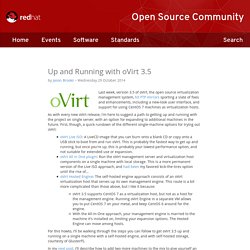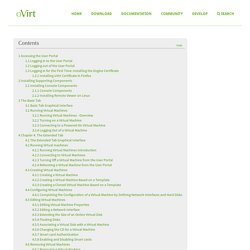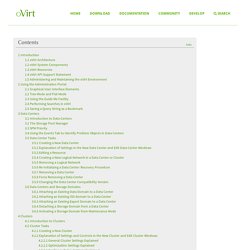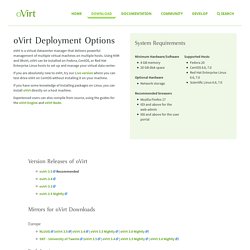

Features/Self Hosted Engine. Self Hosted Engine Name: Self Hosted EngineModules: virt,storageTarget version: 3.4Status: ReleasedLast updated: 2015-01-16 by SandroBonazzola Summary The ability to run the Engine as a VM on the hosts that are managed by this Engine, in an HA configuration, when the Engine VM can start on any of the hosts.

Owner Featue Owner: Sean Cohen: scohen Email: <scohen@redhat.com> Engine Component owner: Sandro Bonazzola Email: <sbonazzo@redhat.com> VSDM Component owner: Current status Initial POC devel Last updated: 2015-01-16 by User:SandroBonazzola Detailed Description This feature will deal with two main issues: The deployment of an Engine as a VM into a fresh setup. Benefit to oVirt This will allow us to deploy less hardware (with the Engine not requiring a separate machine) We will be capable of providing HA for the Engine out of the box, instead of using a separate cluster in order to make the Engine HA. Requirements New installation should be simple and guided.
Detailed Description. Up and Running with oVirt 3.5. Last week, version 3.5 of oVirt, the open source virtualization management system, hit FTP mirrors sporting a slate of fixes and enhancements, including a new-look user interface, and support for using CentOS 7 machines as virtualization hosts.

As with every new oVirt release, I'm here to suggest a path to getting up and running with the project on single server, with an option for expanding to additional machines in the future. First, though, a quick rundown of the different single-machine options for trying out oVirt: oVirt Live ISO: A LiveCD image that you can burn onto a blank CD or copy onto a USB stick to boot from and run oVirt. This is probably the fastest way to get up and running, but once you're up, this is probably your lowest-performance option, and not suitable for extended use or expansion. oVirt All in One plugin: Run the oVirt management server and virtualization host components on a single machine with local storage. Prerequisites. oVirt User Guide. Logging in to the User Portal Log in to the oVirt User Portal directly from your web browser.

Procedure 1.1. Logging in to the User Portal Enter the provided User Portal URL in the address bar of your web browser. The address must be in the format of The login screen displays.Alternately, enter the provided server address into the web browser, to access the welcome screen. Figure 1.3. Logging out of the User Portal Logging out of the User Portal: At the title bar of the User Portal, click Sign out. Administration Guide. oVirt Architecture An oVirt environment consists of: Virtual machine hosts using the Kernel-based Virtual Machine (KVM).

Agents and tools running on hosts including VDSM, QEMU, and libvirt. These tools provide local management for virtual machines, networks and storage. oVirt; a centralized management platform for the oVirt environment. Figure 1.1. oVirt Platform Overview oVirt System Components The oVirt version 3.4 environment consists of one or more hosts (either Red Hat Enterprise Linux 6.5 or later hosts (or similar), Fedora 19, or oVirt Node 6.5 or later hosts) and at least one instance of oVirt.
Hosts run virtual machines using KVM (Kernel-based Virtual Machine) virtualization technology. oVirt runs on a Red Hat Enterprise Linux (or similar) server, as well as Fedora 19, and provides interfaces for controlling the oVirt environment. Download. Version Releases of oVirt Mirrors for oVirt Downloads Europe North America GPG Keys used by oVirt Important: We are going to sign RPMs only from next release.

How does oVirt Project use GPG keys to sign packages? Importing Keys Manually For some repositories, such as repositories with stable in default configuration, yum is able to find a proper key for the repository and asks the user for confirmation before importing the key if the key is not already imported into the rpm database.
To get the public key: $ gpg --recv-keys --keyserver subkeys.pgp.net FE590CB7 $ gpg --list-keys --with-fingerprint FE590CB7 --- pub 2048R/FE590CB7 2014-03-30 [expires: 2016-04-02] Key fingerprint = 31A5 D783 7FAD 7CB2 86CD 3469 AB8C 4F9D FE59 0CB7 uid oVirt <infra@ovirt.org> sub 2048R/004BC303 2014-03-30 --- $ gpg --export --armor FE590CB7 > ovirt-infra.pub # rpm --import ovirt-infra.pub Importing keys Automatically yum install Verifying a package rpm {-K|--checksig} PACKAGE_FILE ... Currently used keys.